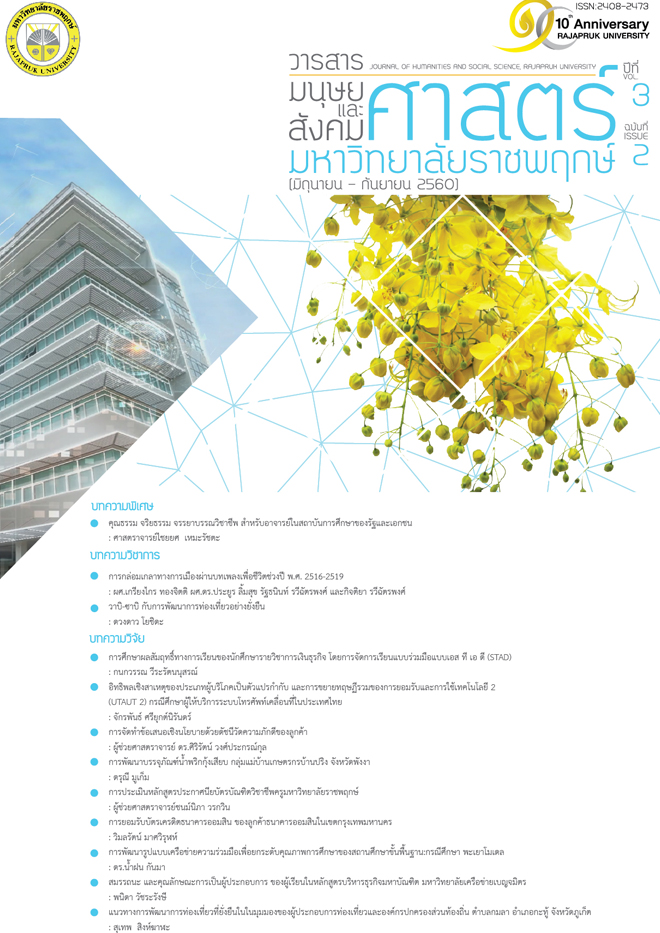侘寂 Wabi – Sabi
Main Article Content
Abstract
This article aims to present the way to achieve sustainable tourism development by introducing the concept of aesthetic beauty that is imperfect in the style of Wabi-Sabi. This concept is about the harmonization between nature material and environment with balance and beauty, the heart of beauty of Zen. This concept can be applied to the tourism area planning development in order to achieve balance and beauty under environment they remain the same or minimal change leading to be the balanced and beautifulstyle of Wabi-Sabi.
Article Details
How to Cite
โยชิดะ ด. (2017). 侘寂 Wabi – Sabi. Journal of Humanities and Social Sciences, Rajapruk University, 3(2), 23–30. retrieved from https://so03.tci-thaijo.org/index.php/rpu/article/view/112586
Section
Academic Articles
References
ชัชพล ทรงสุนทรวงศ์. (2545).การท่องเที่ยวอย่างยั่งยืนในการจัดการนันทนาการและการท่องเที่ยวทางธรรมชาติ หน่วยที่ 1-7.นนทบุรี: สำนักพิมพ์มหาวิทยาลัยสุโขทัยธรรมาธิราช.
นครินทร์ ชัยแก้ว. (2545). การท่องเที่ยวเชิงนิเวศในอาเภอแม่แจ่ม จังหวัดเชียงใหม่ พัฒนาการรูปแบบการจัดการและศักยภาพในการพัฒนาที่ยั่งยืน.วิทยานิพนธ์วิทยาศาสตรมหาบัณฑิต มหาวิทยาลัยเชียงใหม่.
สมาคม ไทย -ญี่ปุ่น (2553).กระจกส่องญี่ปุ่น.พิมพ์ครั้งที่ 2. กรุงเทพฯ: ดวงกมลสมัย.
สมเกียรติ ตั้งนโม. (2553). สุนทรียศาสตร์อินเดีย, จีน, และญี่ปุ่น (ฉบับย่อ). สืบค้นเมื่อ 3ธันวาคม 2557, จาก weread.in.th/wp-content/upload
Atkins, S. &Murphy, K. (1994). Reflection practice. Nursing Standard,8(39), June. 49-54. Baxter
Charles R. Goeldner and J.R. Brent Ritchie. (2006). Tourism: Principle, Practice, Philosophies.10th ed. New York: Chichester: Wiley.
Pramote Patana. (ม.ป.ป.). การออกแบบจัดสวนของญี่ปุ่น. ค้นเมื่อ 3 มกราคม 2560 จาก http://fdesignbasis.blogspot.com/
นครินทร์ ชัยแก้ว. (2545). การท่องเที่ยวเชิงนิเวศในอาเภอแม่แจ่ม จังหวัดเชียงใหม่ พัฒนาการรูปแบบการจัดการและศักยภาพในการพัฒนาที่ยั่งยืน.วิทยานิพนธ์วิทยาศาสตรมหาบัณฑิต มหาวิทยาลัยเชียงใหม่.
สมาคม ไทย -ญี่ปุ่น (2553).กระจกส่องญี่ปุ่น.พิมพ์ครั้งที่ 2. กรุงเทพฯ: ดวงกมลสมัย.
สมเกียรติ ตั้งนโม. (2553). สุนทรียศาสตร์อินเดีย, จีน, และญี่ปุ่น (ฉบับย่อ). สืบค้นเมื่อ 3ธันวาคม 2557, จาก weread.in.th/wp-content/upload
Atkins, S. &Murphy, K. (1994). Reflection practice. Nursing Standard,8(39), June. 49-54. Baxter
Charles R. Goeldner and J.R. Brent Ritchie. (2006). Tourism: Principle, Practice, Philosophies.10th ed. New York: Chichester: Wiley.
Pramote Patana. (ม.ป.ป.). การออกแบบจัดสวนของญี่ปุ่น. ค้นเมื่อ 3 มกราคม 2560 จาก http://fdesignbasis.blogspot.com/


